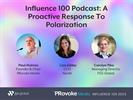Holmes Report 21 Apr 2013 // 11:00PM GMT
Neil Cohen, VP of marketing at Visage, is using content to help the mobility solutions company close deals. He talks to the Holmes Report about the inception of its owned media channel “Chief Mobility Officer” and using content to shorten the sales cycle.
How did you formulate your content strategy?
When I came on board about a year ago, we had just received a great round of series C funding and we were using a marketing automation tool. But it didn’t help us entirely solve the problem of -- whether you catch a customer at the top, middle or end of the funnel, how do you keep them engaged?
I needed content for this, for relationship building. I didn’t want our salespeople to have to ask customers if they were ready to sign a contract in follow-up. I wanted them to be able to say, “hey, remember that conversation we had around the legal ramifications of BYOD? You might appreciate this post on it.” At the time, we had no whitepapers and our blog was very us-centric. But we did have a mobility policy template for companies to download and use -- and that was very popular.
How did this approach inform the type of content you were producing?
Over the last few years, the conversations around mobility were all about security. That’s not a conversation. The questions [to build content around] are: how will mobility make you more competitive -- or more productive? If we’re going to do a content program, we needed to yank and pull the category out of a security-centric conversation. Yes, that’s a great base layer but there’s so much more to this. The content should elevate the conversation.
How does content correspond with various points in the sales funnel?
For people at the top of the funnel, it’s often the light and fun content that draws them in, like the top 50 ringtones that corporations are paying for. Once they’re in the middle, trust is established and they’re more likely to download a whitepaper or an on-demand webinar. At the bottom of the funnel, it’s just about staying engaged and continuing the relationship without constantly pushing the close.
What kind of resources does it take to do this well? Should this be a slice of a PR remit?
I work with Original9Media [a division of LaunchSquad] for “Chief Mobility Officer” and SparkPR for PR. I see these things as two separate buckets and wanted to make sure I had a church-and-state separation. I didn’t want PR-style writing on the blog and didn’t want bloggers doing my PR. “Chief Mobility Officer” and my PR budget are my biggest spend. It’s a low-six figure investment, so you don’t need to be too crazy. It just has to be right and on strategy.
How is “Chief Mobility Officer” -- or all content -- measured?
With Marketo’s opportunity analyzer, we’ll be able to put an ROI against dollars invested and closed business. We’re able to see the impact that content is having on our ability to bring a lead up the sales process. The prospects who use the most content, move faster through the sales cycle. Already, the blog accounts for two-thirds of our website traffic and, on average, 20 percent of people who visit website from the blog are real prospects.
How did you get the rest of the c-suite on board for content?
It was a challenge because it was not how we did things. When I joined, we had a newsletter that went out to 2,800 people but we had 50,000 people in our database. When we launched “Chief Mobility Officer,” we used the content for our newsletter and sent this to the full database. Of course, a few thousand contacts were no longer relevant and about 500 people unsubscribed, but otherwise, we were able to obtain sales data hygiene this way. Ultimately, it was clear that staying in touch with leads via non-promotional content gave us permission to stay engaged.


































.jpg)































